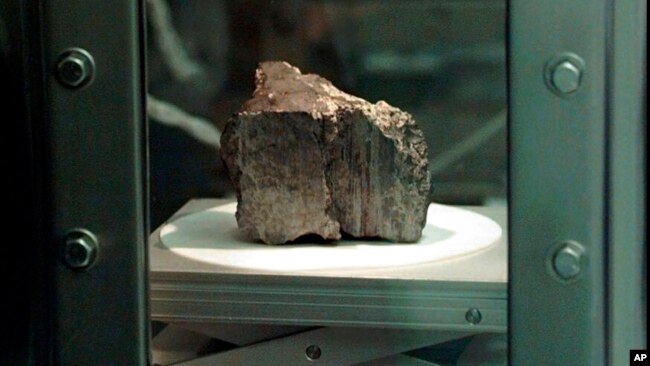남극에서 발견된 운석의 닉세스 화성 생명체를 연구하세요
Study Nixes Mars Life in Meteorite Found in Antarctica
페이지 정보
작성자 Associated Press 작성일 22-01-13 19:13 댓글 0본문

파일 - ALH84001이라는 이름의 운석은 1996년 8월 7일 휴스턴에 있는 존슨 우주 센터 연구소의 한 방에 앉아 있습니다. 과학자들은 화성에서 온 운석에 고대 화성의 생명체가 있었다는 증거가 없다는 것을 확인했다고 말했습니다.
FILE - The meteorite labeled ALH84001 sits in a chamber at a Johnson Space Center lab in Houston, Aug. 7, 1996. Scientists say they've confirmed the meteorite from Mars contains no evidence of ancient Martian life.
플로리다 주 케이프 커내버럴입니다!
CAPE CANAVERAL, FLORIDA —
수십 년 전 지구에 돌풍을 일으켰던 40억 년 된 화성 운석이 결국 고대 원시 화성의 생명체에 대한 증거를 담고 있지 않다고 과학자들이 목요일(현지시간) 발표했습니다.
A 4-billion-year-old meteorite from Mars that caused a splash here on Earth decades ago contains no evidence of ancient, primitive Martian life after all, scientists reported Thursday.
1996년, 나사가 이끄는 팀은 암석의 유기 화합물이 생물에 의해 남겨진 것으로 보인다고 발표했습니다. 다른 과학자들은 회의적이었고, 연구원들은 수십 년 동안 그 전제를 조금씩 줄였는데, 가장 최근에 카네기 과학 연구소의 앤드류 스틸 팀이 이끌었습니다.
In 1996, a NASA-led team announced that organic compounds in the rock appeared to have been left by living creatures. Other scientists were skeptical, and researchers chipped away at that premise over the decades, most recently by a team led by the Carnegie Institution for Science's Andrew Steele.
이 운석의 작은 샘플들은 탄소가 풍부한 화합물들이 실제로 오랜 시간 동안 암석 위로 흘러내린 물의 결과라는 것을 보여줍니다. 이 연구결과는 사이언스지에 실렸습니다.
Tiny samples from the meteorite show the carbon-rich compounds are actually the result of water — most likely salty, or briny, water — flowing over the rock for a prolonged period, Steele said. The findings appear in the journal Science.
화성의 습기와 초기 과거 동안, 적어도 두 번의 충돌이 일어났고, 세 번째 충돌이 화성을 붉은 행성으로 튕겨나가 수백만 년 전에 우주로 보내기 전에 행성의 주변 표면을 뜨겁게 달구었습니다. 이 2 킬로그램의 바위는 1984년 남극에서 발견되었습니다. 남극에서 발견되었습니다.
During Mars' wet and early past, at least two impacts occurred near the rock, heating the planet's surrounding surface, before a third impact bounced it off the red planet and into space millions of years ago. The 2-kilogram (4-pound) rock was found in Antarctica in 1984.
화성에 있는 동안 암석의 틈새로 흐르는 지하수가 존재하는 작은 탄소 덩어리를 형성했다고 연구원들이 밝혔습니다. 같은 일이 지구에서도 일어날 수 있고 화성 대기의 메탄의 존재를 설명하는데 도움을 줄 수 있다고 그들은 말했습니다.
Groundwater moving through the cracks in the rock, while it was still on Mars, formed the tiny globs of carbon that are present, according to the researchers. The same thing can happen on Earth and could help explain the presence of methane in Mars' atmosphere, they said.
그러나 원래의 연구에 참여한 두 명의 과학자들은 실망스럽다고 말하며 이러한 최근의 발견을 문제 삼았습니다. 공유된 이메일에서, 그들은 1996년 관찰 결과를 고수하고 있다고 말했습니다.
But two scientists who took part in the original study took issue with these latest findings, calling them disappointing. In a shared email, they said they stand by their 1996 observations.
휴스턴에 있는 나사 존슨 우주 센터의 운석 재료 연구원인 케이티 토마스-케프르타와 사이먼 클레멧은 "제시된 데이터가 (운석에 대한) 우리의 지식을 증가시켜주기는 하지만, 이 해석은 거의 새로운 것도 아니며, 연구에 의해 뒷받침되는 것도 아니다"라고 썼다.
"While the data presented incrementally adds to our knowledge of (the meteorite), the interpretation is hardly novel, nor is it supported by the research," wrote Kathie Thomas-Keprta and Simon Clemett, astromaterial researchers at NASA's Johnson Space Center in Houston.
그들은 운석에 있는 "지원되지 않는 추측은 유기물질의 기원을 둘러싼 난제를 해결하는 데 아무런 도움이 되지 않는다"고 덧붙였습니다.
"Unsupported speculation does nothing to resolve the conundrum surrounding the origin of organic matter" in the meteorite, they added.
Steelle에 따르면, 기술의 발전이 그의 팀의 새로운 발견을 가능하게 했다고 합니다.
According to Steele, advances in technology made his team's new findings possible.
그는 초기 연구자들의 측정을 칭찬했고, 그들의 생명에 대한 가설은 당시 "합리적 해석"이었다고 언급했습니다. 그는 자신과 나사, 독일, 그리고 영국 과학자들이 포함된 그의 팀은 그들의 결과를 "있는 그대로의 모습"으로 발표하는데 신경을 썼다고 말했는데, 이것은 화성에 대한 매우 흥미로운 발견이며 원래의 전제를 반증하기 위한 연구가 아니다.
He commended the measurements by the original researchers and noted that their life-claiming hypothesis "was a reasonable interpretation" at the time. He said he and his team, which includes NASA, German and British scientists, took care to present their results "for what they are, which is a very exciting discovery about Mars and not a study to disprove" the original premise.
이 발견은 "이 행성에서 생명체가 어떻게 시작되었는지에 대한 우리의 이해에 큰 도움이 되고 화성, 즉 엔셀라두스와 유로파의 다른 곳에서 생명체를 찾는데 필요한 기술을 다듬는데 도움을 줍니다," 라고 스틸이 이메일에서 토성과 지표면 아래 바다가 있는 목성의 위성을 언급하며 말했습니다.
This finding "is huge for our understanding of how life started on this planet and helps refine the techniques we need to find life elsewhere on Mars, or Enceladus and Europa," Steele said in an email, referring to Saturn and Jupiter's moons with subsurface oceans.
스틸에 따르면, 화성에 미생물이 살았는지 아니면 아직 존재하는지 증명하는 유일한 방법은 분석을 위해 샘플을 지구로 가져오는 것입니다. NASA의 Perseverance 화성 탐사선은 10여 년 만에 지구로 귀환하기 위해 6개의 샘플을 수집했습니다. 36개의 샘플이 필요합니다.
The only way to prove whether Mars ever had or still has microbial life, according to Steele, is to bring samples to Earth for analysis. NASA's Perseverance Mars rover has collected six samples for return to Earth in a decade or so; three dozen samples are desired.
우주를 표류한 지 수백만 년 후, 이 운석은 수천 년 전에 남극의 얼음밭에 떨어졌습니다. 이 작은 회녹색 조각은 앨런 힐스 84001이라는 이름이 발견되었던 언덕에서 유래했습니다.
Millions of years after drifting through space, the meteorite landed on an icefield in Antarctica thousands of years ago. The small gray-green fragment got its name — Allan Hills 84001 — from the hills where it was found.
출처 : VOANews
댓글목록 0
등록된 댓글이 없습니다.

















